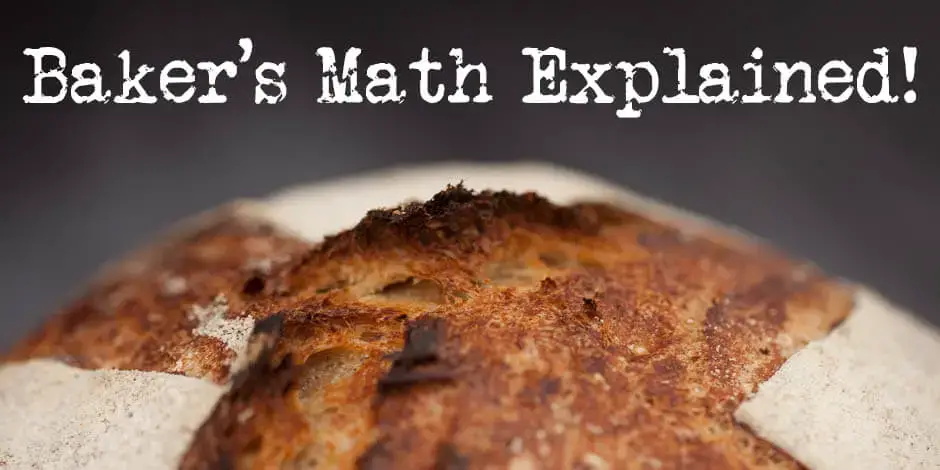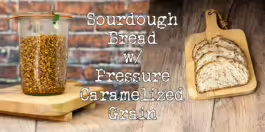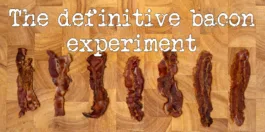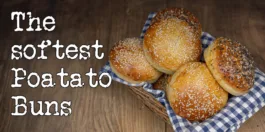Do you know this? You look at a sourdough bread recipe, and there are many percentages on it, but when you add them all up, it’s way above 100%? That’s very confusing. So, what’s up? In this article, baker’s math and baker’s percentages will be explained. Knowing this will help you become a better baker.
Baker’s math and baker’s percentages are pretty universally accepted conventions for describing baked recipes. They’re unique because they always scale the percentage from the total flour. This means any and all flour in the recipe is always 100%.
Knowing baker’s math allows you to scale recipes and generalize them to easily remember them. It will also help you learn how to make your recipes.
If you want to watch the information in this article as a video, you can watch it here:
Note about the formulae in Baker’s Math
In this article, I will be using three different variable names in the formulas:
| w | Denotes weight in any unit of your choice |
| p | Denotes a percentage |
| h | Denotes hydration as a percentage |
Calculation from percentages to weight
Let’s assume this simple recipe:
Simple Sourdough Bread
by Foodgeek
100% flour
67% water
20% starter (100% hydration)
2% saltIf the recipe uses more than one type of flour, the sum of the percentages should be 100%.
If you want to calculate the weight of any ingredient, you can use this simple formula:
$$w_{ingredient}=\frac{p_{ingredient} \times {w_{flour}}}{100}$$
So, given that we want a total flour weight of 1500g, we’d calculate the weight of the water the following way:
$$\begin{aligned}
w_{water}&=\frac{67 \times 1500g}{100}\\
&=1005g
\end{aligned}$$
Using the exact same formula for the starter and the salt, we get the following recipe:
Simple Sourdough Bread
by Foodgeek
1500g flour
1005g water
300g starter (100% hydration)
30g saltCalculation from weight to percentages
If you want to generalize a recipe, you can also go from a recipe to percentages.
Pretty Simple Sourdough Bread
by Foodgeek
423g bread flour
106g whole-grain wheat flour
354g water
106g starter (100% hydration)
11g saltObviously, the 423g of bread flour + 106g of whole-grain wheat flour is 100%. So we’ll need the total for the rest of the calculations:
$$\begin{aligned}
w_{flour} &= 423g + 106g\\
&= 529g
\end{aligned}$$

So, to calculate the percentage of an ingredient, we’ll use this formula:
$$p_{ingredient}=100 \times \frac{w_{ingredient}}{w_{flour}}$$
So for water, it’d be:
$$\begin{aligned}
p_{water}&=100 \times \frac{354g}{529g}\\
&= 67\%
\end{aligned}$$
So, after we’ve converted all the ingredients, we end up with this recipe:
Pretty Simple Sourdough Bread
by Foodgeek
80% bread flour
20% whole-grain wheat flour
67% water
20% starter (100% hydration)
2% saltHow do you calculate hydration in a bread recipe?
To calculate the hydration in the dough, you need to add up all the flour and all the fluids and use this formula:
$$h_{dough}=100 \times \frac{w_{fluid}}{w_{flour}}$$
If you have a starter with a different hydration than 100%, you can calculate the weight of the flour and the water in the starter by using these formulas:
$$\begin{aligned}
w_{starter fluid} &= \frac{w_{starter} \times h_{starter}}{h_{starter} + 1}\\
w_{starter flour} &= w_{starter} – w_{starter fluid}
\end{aligned}$$
If your starter is 100% hydrated, you can divide its weight by 2 and assign the result to both the weight of the flour and water in the starter.
So, given this recipe:
Pretty Simple Sourdough Bread
by Foodgeek
423g bread flour
106g whole-grain wheat flour
354g water
106g starter (100% hydration)
11g saltWe’ll calculate this:
$$\begin{aligned}
w_{flour} &= (423g + 106g) + \frac{106g}{2}\\
&=582g\\
w_{fluid} &= 354g + \frac{106g}{2}\\
&= 407g\\
h_{dough} &= 100 \times \frac{407g}{582g}\\
&= 70\%
\end{aligned}$$
Commonly used baker’s percentages in baker’s math
When developing recipes, there are a couple of percentages that will help you:
How much sourdough starter do I put into my dough?
The amount of starter in a recipe is usually between 10% and 30%. The amount you put in the dough depends on the fermentation speed you want to achieve. The more you put in the dough, the faster the fermentation will be.
So, if you are working at warm temperatures, you will probably want to use less sourdough starter. If you work at colder temperatures, you’d probably want to go high. My go-to amount is 20% when working at a common room temperature of 21°C/70°F.
How much salt do I put in?
The amount of salt that you put in the dough will affect the retardation of the dough, but for taste, around 2% of salt seems to be a good place to be.
How much water do I put in?
When it comes to hydration, it can make a big difference what kind of bread that you will end up with:
| Hydration | Description |
|---|---|
| 50%-57% | Dry dough. Hard to knead. Dense crumb. |
| 58%-67% | Tacky but not sticky. Easily kneaded. Relatively dense crumb |
| 68%-85% | Wet dough. From slightly sticky at the lower end to very hard to work with at the high end. From a somewhat open crumb to extremely open (this paired with how the dough is handled) |
| Above 85% | Not commonly used for bread doughs, but some (relatively insane bakers) will be making these breads. |
Note that flours are not the same when it comes to hydration. Using all-purpose or bread flour only in a recipe may result in a very wet dough at a certain hydration, whereas if you were to put some whole-grain flour in, it might be a lot more manageable at the same hydration. So keep this in mind when developing a recipe.
Use my Bread Calculator. It has Baker’s Math built-in
Now that you understand how it works, you can use my Bread Calculator, which will calculate all the information you need on the fly.
It also helps you scale the recipe from the total weight and the total flour weight, change hydration, convert a yeasted recipe to sourdough, permanently save the recipe, and print it.
I developed all my recipes in this tool, and it was made to support my workflow. If you have any suggestions for the Bread Calculator, please contact me with your ideas, praise, and comments.
Please share this article on Baker’s Math on social media
This article has explained what baker’s math and baker’s percentages are and how they are used. If you learned something, please consider this article with fellow bakers.











Love the way you explain everything, love that its simple and direct. thank you for the information.
Thank you <3
Thanks a million for this. As a home baker just into sourdough for a short while, this is indispensable!
I’ve found your website through your fantastic Odysee channel. Glad that you’re there as I hate JewTube and don’t visit that filthy place since they went full blown 1984 style censor machine the time when this scamdemic started. This site is also awesome. Hats off to you. Learning is a superb experience with you. Keep up the good work.